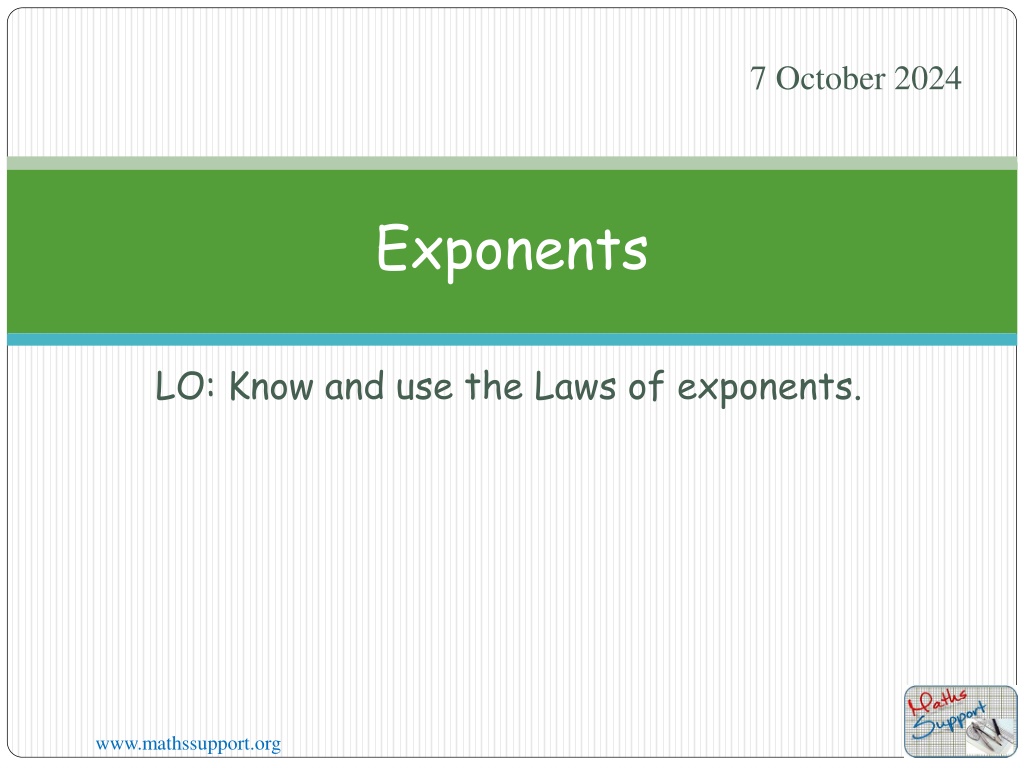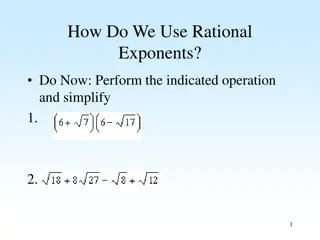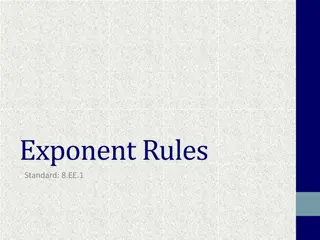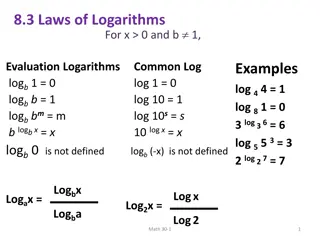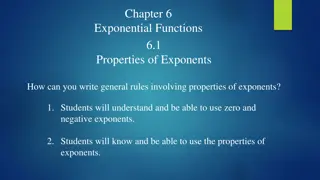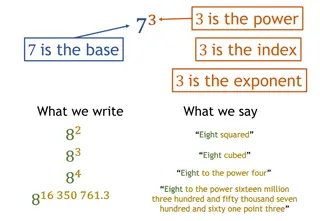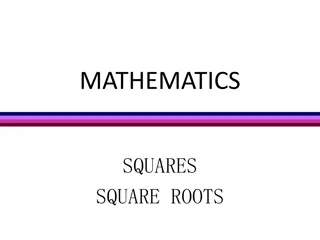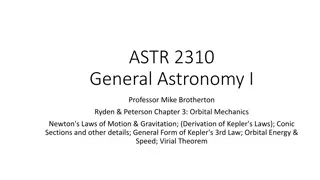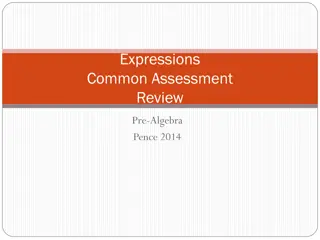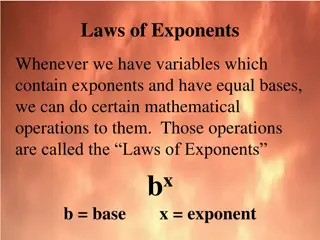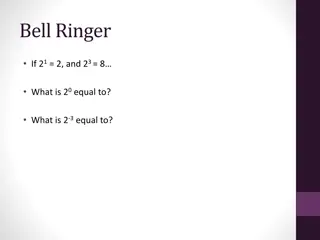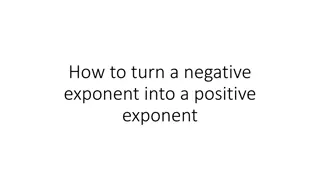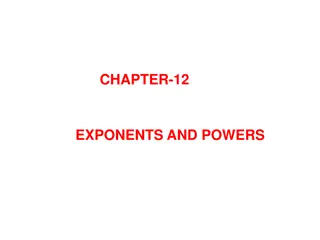Understanding Exponents: Laws and Calculations in Mathematics
Exponents are a shorthand way of representing repeated multiplication. This content explores using index notation, calculating powers with a GDC, and the laws of exponents when multiplying numbers with the same base. Discover how to proficiently work with exponents and enhance your mathematical skills.
Download Presentation

Please find below an Image/Link to download the presentation.
The content on the website is provided AS IS for your information and personal use only. It may not be sold, licensed, or shared on other websites without obtaining consent from the author. Download presentation by click this link. If you encounter any issues during the download, it is possible that the publisher has removed the file from their server.
E N D
Presentation Transcript
7 October 2024 Exponents LO: Know and use the Laws of exponents. www.mathssupport.org
Exponents We use exponents as a shorthand way of representing the repeated multiplication of a number by itself. For example, we can use index notation to write 2 2 2 2 2 as Exponent, index or power 25 base This number is read as two to the power of five . 25 = 2 2 2 2 2 = 32 www.mathssupport.org
Index notation Evaluate the following: 62 = 6 6 = 36 When we raise a negative number to an odd power the answer is negative. 34 = 3 3 3 3 =81 ( 5)3 = 5 5 5 = 125 27 = 2 2 2 2 2 2 2 =128 When we raise a negative number to an even power the answer is positive. ( 1)5 = 1 1 1 1 1 = 1 ( 4)4 = 4 4 4 4 = 64 www.mathssupport.org
Calculating powers We can use the GDC to find powers. For example, to calculate the value of 74 we key in: www.mathssupport.org
Calculating powers We can use the GDC to find powers. For example, to calculate the value of 74 we key in: www.mathssupport.org
Calculating powers We can use the GDC to find powers. For example, to calculate the value of 74 we key in: www.mathssupport.org
Calculating powers We can use the GDC to find powers. For example, to calculate the value of 74 we key in: www.mathssupport.org
Calculating powers We can use the GDC to find powers. For example, to calculate the value of 74 we key in: The calculator shows this as 2401. 74 = 7 7 7 7 = 2401 www.mathssupport.org
multiplication Laws of exponents - When we multiply two numbers written in index form and with the same base we can see an interesting result. For example, 34 32 =(3 3 3 3) (3 3) = 3 3 3 3 3 3 = 36 a3 a5 = (a a a) (a a a a a) = a a a a a a a a = a8 What do you notice? When we multiply two numbers with the same base the indices are added. = 3(4 + 2) = a(3 + 5) am an =a(m + n) www.mathssupport.org
Laws of exponents - When we multiply two powers with different bases but the same exponent we can see an interesting result. For example, a4 b4 = (a a a a) (b b b b) = ab ab ab ab = (ab)4 multiplication What do you notice? When we multiply two powers with different bases but the indices are the same is equal to the product of the bases with the same exponent an bn = (ab) n www.mathssupport.org
Laws of exponents - division When we divide two numbers written in index form and with the same base we can see another interesting result. For example, 45 42 =4 4 4 4 4 4 4 a6 a4 = a a a a =4 4 4 = 43 = 4(5 2) a a a a a a = a(6 4) = a a = a2 What do you notice? When we divide two numbers with the same base the indices are subtracted. am an = a(m - n) www.mathssupport.org
Laws of exponents - division When we divide two powers with different bases but the same exponent, we can see another interesting result. For example, a a a a a b b b b b =a b b b b b b a5 b5 = 5 a b 5 5 a a a a a ( ) = What do you notice? When we divide two powers with different bases but the indices are the same, is equal to the quotient of the bases with the same exponent. n n a b n a b = ( ) www.mathssupport.org
Raising to a power Laws of exponents - When we raise a power to another power we can see another interesting result. For example, (34)2 = (3 3 3 3) = 3 3 3 3 3 3 3 3 = 38 (a2)5 =(a a) = a a a a a a a a a a = a10 What do you notice? When we raise a power to another power the indices are multiplied. (3 3 3 3) = 3(4 2) (a a) (a a) (a a) (a a) = a(2 5) (am)n = am n www.mathssupport.org
The power zero Look at the following division: 64 64 = 1 Using the second index law, 64 64 = 6(4 4) = 60 That means that, 60 = 1 Any number raised to the power of zero is equal to one. For example, 100 = 1 3.4520 = 1 723 538 5920 = 1 a0 = 1 a0 = 1 www.mathssupport.org
Negative exponents Look at the following division: 34 36 Using the second index law, 34 36 = 3(4 6) = 3-2 Solving the division, 34 36 =3 3 3 3 3 3 3 3 3 3= a2 a5 = a a a a a 1 1 = = 3 2 1 32 = 3 3 1 a a = a 3 =a a a a3 What do you notice? When we raise a number to a negative power, is the same as one over the number with positive power. 1 a-n =an www.mathssupport.org
Negative exponents 1 a-n = an Using the negative exponent law, Express the following with positive exponent 4 5 1 = 4 5 45 1 Express the following with negative exponent 52 1 = 5 2 52 -3 2 ( ) Express the following with positive exponent 2 ( ) 3 2-3 -3 33 3 2 -3 27 = =8 = 3 3 www.mathssupport.org
Thank you for using resources from A close up of a cage Description automatically generated For more resources visit our website https://www.mathssupport.org If you have a special request, drop us an email info@mathssupport.org www.mathssupport.org
